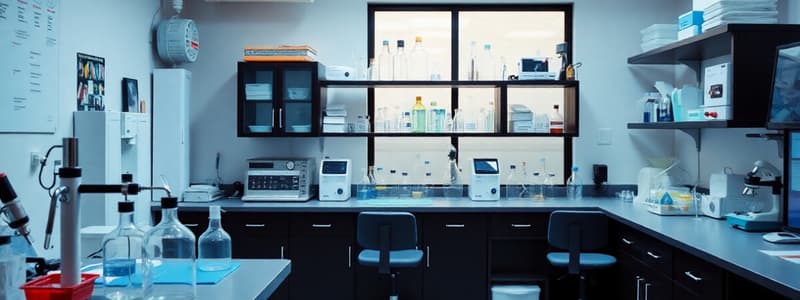Podcast
Questions and Answers
What is the primary function of a laboratory room?
What is the primary function of a laboratory room?
A laboratory room is designed for scientific research, experimentation, analysis, and measurement.
What is the importance of safety goggles in a laboratory?
What is the importance of safety goggles in a laboratory?
Safety goggles protect your eyes from chemicals, heated materials, and potential projectiles.
Explain two reasons why it's important to keep your work area uncluttered in a laboratory.
Explain two reasons why it's important to keep your work area uncluttered in a laboratory.
A cluttered work area increases the risk of accidents and makes it difficult to move around safely.
What is the main distinguishing feature between prokaryotic and eukaryotic cells?
What is the main distinguishing feature between prokaryotic and eukaryotic cells?
Give an example of an organism that is classified as a prokaryote.
Give an example of an organism that is classified as a prokaryote.
What is the significance of safety signs in a laboratory environment?
What is the significance of safety signs in a laboratory environment?
Why is it important to wash your hands after handling chemicals in a laboratory?
Why is it important to wash your hands after handling chemicals in a laboratory?
Explain the importance of knowing the location of safety equipment like a fire extinguisher and eyewash station in a lab.
Explain the importance of knowing the location of safety equipment like a fire extinguisher and eyewash station in a lab.
What are the primary differences in DNA structure between prokaryotic and eukaryotic cells?
What are the primary differences in DNA structure between prokaryotic and eukaryotic cells?
Explain the significance of membrane-bound organelles in eukaryotic cells.
Explain the significance of membrane-bound organelles in eukaryotic cells.
What is the primary method of cell division in prokaryotic cells, and how does it differ from eukaryotic cell division?
What is the primary method of cell division in prokaryotic cells, and how does it differ from eukaryotic cell division?
Describe the key characteristic that distinguishes bacteria from other types of microorganisms, such as fungi and viruses.
Describe the key characteristic that distinguishes bacteria from other types of microorganisms, such as fungi and viruses.
Explain the difference between free-living bacteria and parasitic bacteria.
Explain the difference between free-living bacteria and parasitic bacteria.
What specific structure in the bacterial cell wall distinguishes bacteria from other types of microorganisms?
What specific structure in the bacterial cell wall distinguishes bacteria from other types of microorganisms?
What are the two main methods used to classify bacteria, and provide an example of each.
What are the two main methods used to classify bacteria, and provide an example of each.
Explain why the size difference between prokaryotic and eukaryotic cells is significant.
Explain why the size difference between prokaryotic and eukaryotic cells is significant.
What are the three main types of membrane-bound organelles found in eukaryotic cells?
What are the three main types of membrane-bound organelles found in eukaryotic cells?
How does the DNA structure of prokaryotic cells differ from that of eukaryotic cells?
How does the DNA structure of prokaryotic cells differ from that of eukaryotic cells?
What is the primary method of cell division in prokaryotes? How does it differ from eukaryotic cell division?
What is the primary method of cell division in prokaryotes? How does it differ from eukaryotic cell division?
What are the two main methods used to classify bacteria?
What are the two main methods used to classify bacteria?
Give one example of a eukaryotic organism that is multicellular and one example of a eukaryotic organism that is single-celled.
Give one example of a eukaryotic organism that is multicellular and one example of a eukaryotic organism that is single-celled.
What is the distinguishing characteristic of prokaryotic cells that distinguishes them from eukaryotic cells?
What is the distinguishing characteristic of prokaryotic cells that distinguishes them from eukaryotic cells?
Describe the two main modes of existence for bacteria.
Describe the two main modes of existence for bacteria.
What is the primary component of the bacterial cell wall, and how does it differ from the cell walls of other microorganisms?
What is the primary component of the bacterial cell wall, and how does it differ from the cell walls of other microorganisms?
Name three different forms of bacterial aggregation, providing a brief description of each.
Name three different forms of bacterial aggregation, providing a brief description of each.
Why are contact lenses discouraged in a laboratory environment?
Why are contact lenses discouraged in a laboratory environment?
What specific feature distinguishes prokaryotes from eukaryotes?
What specific feature distinguishes prokaryotes from eukaryotes?
What is the purpose of a fire blanket in a laboratory setting?
What is the purpose of a fire blanket in a laboratory setting?
List three potential hazards that could be found in a laboratory setting.
List three potential hazards that could be found in a laboratory setting.
Why is it important to listen carefully to instructions before conducting a laboratory experiment?
Why is it important to listen carefully to instructions before conducting a laboratory experiment?
Give an example of a laboratory instrument and explain its purpose.
Give an example of a laboratory instrument and explain its purpose.
What is the main reason why it is important to roll up loose sleeves before starting a laboratory experiment?
What is the main reason why it is important to roll up loose sleeves before starting a laboratory experiment?
Give an example of a common laboratory glass used for research.
Give an example of a common laboratory glass used for research.
What is the function of an eyewash station in a laboratory setting?
What is the function of an eyewash station in a laboratory setting?
What is the primary function of a Petri dish in a laboratory setting?
What is the primary function of a Petri dish in a laboratory setting?
Flashcards
Laboratory Room
Laboratory Room
A controlled environment for scientific research and experimentation.
Preventive Measures
Preventive Measures
Safety guidelines to follow in a laboratory environment.
Safety Goggles
Safety Goggles
Protective eyewear to shield eyes from hazards in labs.
Prokaryotes
Prokaryotes
Signup and view all the flashcards
Eukaryotes
Eukaryotes
Signup and view all the flashcards
Nucleoid
Nucleoid
Signup and view all the flashcards
Lab Safety Signs
Lab Safety Signs
Signup and view all the flashcards
Cleaning Lab Area
Cleaning Lab Area
Signup and view all the flashcards
Eukaryotic Cells
Eukaryotic Cells
Signup and view all the flashcards
Prokaryotic Cells
Prokaryotic Cells
Signup and view all the flashcards
Cell Division Types
Cell Division Types
Signup and view all the flashcards
Ribosome Sizes
Ribosome Sizes
Signup and view all the flashcards
Cell Wall Composition
Cell Wall Composition
Signup and view all the flashcards
Microbiology
Microbiology
Signup and view all the flashcards
Bacterial Classification
Bacterial Classification
Signup and view all the flashcards
Bacterial Forms
Bacterial Forms
Signup and view all the flashcards
Laboratory Instruments
Laboratory Instruments
Signup and view all the flashcards
Safety Equipment
Safety Equipment
Signup and view all the flashcards
Safety Goggles Usage
Safety Goggles Usage
Signup and view all the flashcards
Emergency Protocols
Emergency Protocols
Signup and view all the flashcards
Handling Chemicals
Handling Chemicals
Signup and view all the flashcards
Lab Clutter Control
Lab Clutter Control
Signup and view all the flashcards
Eating Restrictions in Labs
Eating Restrictions in Labs
Signup and view all the flashcards
Hair and Sleeve Safety
Hair and Sleeve Safety
Signup and view all the flashcards
Cell Structure Classification
Cell Structure Classification
Signup and view all the flashcards
Membrane-bound Organelles
Membrane-bound Organelles
Signup and view all the flashcards
Binary Fission
Binary Fission
Signup and view all the flashcards
Mitosis
Mitosis
Signup and view all the flashcards
Meiosis
Meiosis
Signup and view all the flashcards
Ribosome Size Comparison
Ribosome Size Comparison
Signup and view all the flashcards
Bacterial Aggregation
Bacterial Aggregation
Signup and view all the flashcards
Classification of Microorganisms
Classification of Microorganisms
Signup and view all the flashcards
Study Notes
Laboratory Room
- A laboratory room is a controlled space designed for scientific research, experiments, analysis, and measurements.
- It's equipped with specialized tools, instruments, and safety equipment.
- This allows researchers, scientists, and technicians to conduct experiments accurately and safely.
Laboratory Instruments
- Evaporating Dish: Used for evaporating liquids.
- Bacterial Loop: Used for transferring bacteria in microbiology experiments.
- Bunsen Burner: Used as a heat source.
- Wire Brush: Used for cleaning laboratory glassware or materials.
- Crucible and Cover: Used to heat and manipulate small amounts of materials.
- 24-well Plate: A multi-well plate for performing multiple experiments simultaneously.
- Test-tube rack: Used to store and organize test tubes.
- Mortar and Pestle: Used for grinding substances into a fine powder.
- Lab Burner: Used as a heat source.
- Forceps: Used for handling small objects.
- Wash Bottle: Used for rinsing and cleaning laboratory equipment.
- Pipet: Measures and dispenses specific volumes of liquids.
- Graduated Cylinder: Used to measure liquid volumes.
- Volumetric Flask: Used to accurately prepare solutions with specific volumes.
- Conical Flask: Often used for mixing or heating liquids.
- Dropper: Used to transfer small volumes of liquids.
- Watch Glass: Used for covering beakers or as a reaction vessel, or to observe or evaporate liquids.
- Funnel: Used to transfer liquids into containers with small openings.
- Petri Dishes: Used for growing microorganisms or reactions.
Laboratory Safety Procedures
- Listen to or read instructions carefully.
- Wear safety goggles for eye protection.
- Notify any teacher of spills or accidents.
- Wash hands after handling chemicals with soap and water.
- Keep hands away from the face.
- Tie back long hair.
- Roll up loose sleeves.
- Know the location of safety equipment: fire extinguisher, fire blanket, eyewash station, and first aid kit.
- Keep the work area uncluttered for safe workspace.
- Avoid contact lenses; wear glasses instead.
- Avoid putting things in your mouth.
- Clean up after each lab period.
- No eating or drinking in the lab.
Lab Safety Signs
- Safety signs in laboratories use standardized symbols and instructions.
- They communicate important safety information, aiding in protecting lab personnel from potential hazards, including eye protection, head protection, ear protection, hand protection, respiratory system protection, foot protection, Radioactive materials, Toxic chemicals signs.
Microbiology
- Microbiology is the study of microscopic organisms.
- These can be: unicellular (Bacteria), multicellular (fungi), or acellular (viruses).
- All living organisms are sorted into two groups based on cell type: prokaryotes and eukaryotes.
Prokaryotic Cells
- Simple, single-celled organisms without a nucleus.
- Genomic material (DNA) is not enclosed within a membrane.
- Usually smaller in size.
- Examples include bacteria.
Eukaryotic Cells
- More complex cells that contain a defined nucleus.
- DNA is enclosed in a membrane within the nucleus.
- Cell contains various membrane-bound organelles.
- Examples include fungi, animals, and plants.
Bacterial Forms
Bacteria have various shapes and forms including cocci, coccobacilli, vibrio, bacillus, spirillum, spirochete, diplococci, staphylococci, streptococci, sarcinae, tetrads, diplobacilli, palisades, streptobacilli, coccobacilli, mycobacteria, corynebacteria, spore-forming, streptomycetes, curved forms, spirillium, spirochete, vibrios (curved rods), spirilla, treponema, Borrelia.
Studying That Suits You
Use AI to generate personalized quizzes and flashcards to suit your learning preferences.




